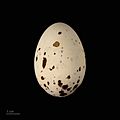Black noddy facts for kids
Quick facts for kids Black noddy |
|
|---|---|
 |
|
| A black noddy at the Tubbataha Reef National Park in the Philippines. | |
| Conservation status | |
| Scientific classification | |
| Genus: |
Anous
|
| Species: |
minutus
|
 |
|
| Global map of eBird reports of this species Nonbreeding Breeding | |
The black noddy or white-capped noddy (Anous minutus) is a type of seabird that belongs to the Laridae family. It is a medium-sized tern with mostly black feathers and a bright white cap on its head. This bird looks a lot like the lesser noddy (Anous tenuirostris). However, the black noddy has slightly darker feathers and dark skin around its eyes, unlike the paler skin of the lesser noddy.
Contents
About the Black Noddy's Name
The black noddy was officially named by a German naturalist and lawyer, Friedrich Boie, in 1844. Its scientific name is Anous minutus.
The first part of its name, Anous, comes from an ancient Greek word meaning "stupid" or "foolish". The second part, minutus, is Latin for "small".
There are seven different types, or subspecies, of the black noddy:
- A. m. worcesteri (McGregor, 1911) - Found near Cavilli Island and Tubbataha Reef in the Sulu Sea.
- A. m. minutus Boie 1844 - Lives in northeast Australia and New Guinea all the way to the Tuamotu Archipelago.
- A. m. marcusi (Bryan, 1903) - Found on Marcus and Wake Islands, and across Micronesia to the Caroline Islands.
- A. m. melanogenys Gray, 1846 - Lives in the Hawaiian Islands.
- A. m. diamesus (Heller & Snodgrass, 1901) - Found on Clipperton Island (off western Mexico) and Cocos Island (off western Costa Rica).
- A. m. americanus (Mathews, 1912) - Lives on islands in the Caribbean Sea.
- A. m. atlanticus (Mathews, 1912) - Found on tropical islands in the Atlantic.
What Does a Black Noddy Look Like?
The black noddy is about 35 to 37 centimeters (14 to 14.5 inches) long. Its wings can spread out to 66 to 72 centimeters (26 to 28 inches) wide. It weighs between 98 and 144 grams (about 3.5 to 5 ounces).
These birds have dark feathers and a light-colored cap on their head. They also have a small white mark under each eye and a white spot above. Their wings are long and pointy, and their tail looks like it's been cut straight across. The bill is black and very sharp. Most black noddies have black feet, but the melanogenys subspecies has orange feet. All their feet are fully webbed, which helps them swim.
How Black Noddies Behave
Black noddies are known for dipping their heads constantly during their breeding season. This behavior might be why they are called "noddies." These birds are very comfortable around people. You can sometimes even pick them up while they are on their nests!
They eat small fish and squid. They catch their food by flying low over the ocean surface and picking up prey. Sometimes, they join other seabirds where bigger fish are chasing smaller fish to the surface, making them easier to catch.
Black noddies build their nests as flat platforms, often in tree branches. They use dried leaves and cover them with their droppings. They lay only one egg each season. These birds often use the same nests year after year. They build nests in many types of trees, but the Pisonia tree is a favorite. Large Pisonia trees can hold many nests. The bird droppings, called guano, add important nutrients to the soil. This helps plants grow on coral islands.
Where Black Noddies Live
Black noddies live all over the world in warm tropical and subtropical seas. They have large colonies in the Pacific Ocean. You can also find smaller groups in the Caribbean, the central Atlantic Ocean, and the northeast Indian Ocean. When they are at sea, they usually stay close to their breeding colonies, within about 80 kilometers (50 miles) of the shore. At night, these birds fly back to their colonies or other islands to rest.
Cultural Importance
For a long time, people in the Pacific Ocean used these birds to find land. Sailors would watch the black noddies flying out to sea to feed during the day and then follow them back to their islands at night. This helped them find unseen islands and atolls.
Gallery
-
Common noddy head - note stouter beak, greyer cap
See also
 In Spanish: Tiñosa menuda para niños
In Spanish: Tiñosa menuda para niños










